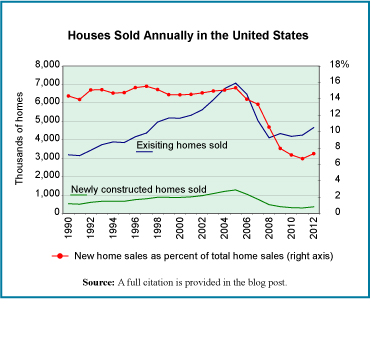The residential housing market in the United States is beginning to show signs of recovery five years after the market crashed. Whiles signs of recovery are there in the number of houses selling as well as the prices they are selling for, confidence in these signs appears to be weak and many in the real estate industry fear that a rise in interest rates could cause the housing market recovery to stall.
The graph shows home sales in the United States by number of new and existing homes sold annually. The percent of total sales made up by the sale of newly constructed homes is shown in red.
Today’s market size is the number and approximate value of newly constructed homes that were sold in 2005 (the peak year in terms of number of homes sold) and in 2012.
Geographic reference: United States
Year: 2005 and 2012
Market size: 1.283 million units for a value of $381.1 billion in 2005 and 364 thousand units in 2012 with a value of $107.5 billion
Source: “New Residentail Sales, Historical Data,” U.S. Census Bureau, last updated on August 12, 2013, available online here.
Original Source: U.S. Bureau of the Census and National Association of Realtors
Posted on September 30, 2013


